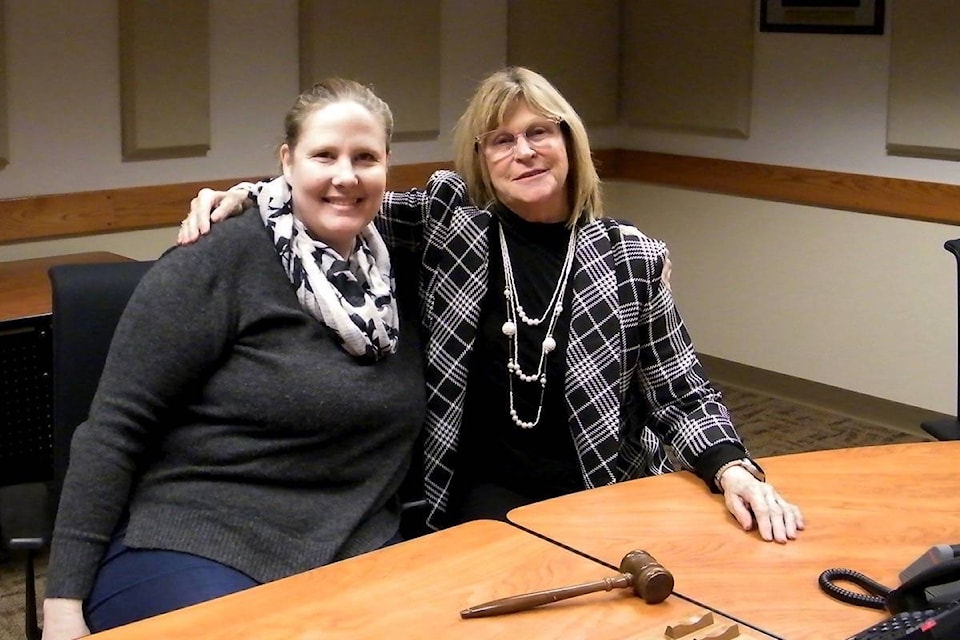When Diane Langman was elected into her first term as board chair of the Regional District of Kootenay Boundary (RDKB) last year, she was definitely ready – admittedly a bit nervous – to lead the table of 12 seasoned directors who oversee a territory that stretches across 8,200 square kilometres and serves more than 31,000 people.
But jump in she did, having served as Mayor of Warfield since 2017, and through that role, gotten her feet wet sitting as the village’s regional director.
Then, a few months in to her first term, the flood gates opened to a behemoth that no one saw coming.
That, of course, being the hit of coronavirus and the ongoing crises the COVID-19 pandemic has caused at every level of government and life.
But work her way through she did, and now Langman is ready to tackle the lead regional role for a second consecutive year.
She was acclaimed to board chair for another one-year term on Nov. 10, with Area C/Christina Lake Director Grace McGregor re-elected as vice-chair.
The Trail Times contacted Langman to ask about the growing pains, her trials and tribulations in such a key role, and what she expects on the road ahead.
“2019/2020 was my first year as board chair so it was challenging not only due to everything 2020 threw at us, but also learning new roles and responsibilities, Langman began.
“This is when you truly learn to appreciate the team you build up around you and I’m incredibly thankful for my council in Warfield, the board of directors and our staff at both Warfield and the RDKB,” she said. “Without a strong team behind me, I feel we would be in a much different place.”
Read more: RDKB published financial breakdown
Read more: RDKB to review freshet response
Her greatest hurdle, not just as an elected leader, but also as a mom-of-two and wife of an emergency first responder, was of course, COVID-19.
But there were also the curveballs life in the Kootenays will occasionally throw at local government, like the strong freshet and flood-risks the Boundary experienced this spring, in tandem with the pandemic.
But she worked through the ups and downs and along the way, discovered a few more unexpected - albeit steadfast - aspects to the role.
“Something I didn’t expect from this position (is that) regional districts function differently from a municipality,” Langman explained. “There are so many different moving pieces all the time and our villages/cities/areas all really differ from one another; we all have different priorities,” she said.
“But despite these differences, we have so many commonalities between us and the RDKB does a great job connecting those pieces together. With small communities, we need to work together in creative ways to provide some of these core services to our residents, and the RDKB has a great model on how this can work successfully.”
Since the regional meetings went virtual in March, Langman’s base has been her home, and travel time is almost nil.
While it’s good in some ways, this new way of doing business does leave her pining for some good old-fashioned back-and-forth.
“I really miss the face-to-face personal interactions, and I’ve also realized that I am really a hugger, so it’s been hard and different,” Langman shared.
‘That being said, virtual meetings have shown their many benefits, and the top of that list is keeping not only all of our directors safe, but also our staff,” she explained.
“We have had a few discussions about this at the board level and while I would love for things to go back to ‘normal,’ we have actually seen an increase in the number of people attending our board meetings to present, or to be a delegation.”
She says there’s been some great dialogue around the virtual table, and because directors and staff aren’t traveling during winter road conditions, there have been savings realized in both travel costs and staff time.
“And with that reduced time in vehicles, our carbon footprint is also lower than when we were meeting face-to-face,” Langman noted. “A fortunate thing is that the RDKB had already done a great deal of work to be digitally ready in the two years before the pandemic hit, so we had the infrastructure … functional. This meant that we were able to continue delivering nearly all our services, with the exception of our indoor recreation services and facilities that were temporarily closed, but are now gradually and safely reopening.”
And there’s another factor that Langman is proud of in regards to regional staff.
“We laid off no staff due to the pandemic and those who worked in recreation took on tasks that needed doing in their departments, and staff pitched in to accomplish work that they may not have otherwise had time to do.”
No lay-offs actually saved the RDKB money in the long term, Langman clarified, saying that recruiting new employees who may not have returned after lay-off would prove very expensive and disruptive to service delivery.
“Most people think laying people off saves money, but not in the context of a limited labour pool and unique skill sets like we have in our recreation departments,” she pointed out.
“And, those staff we have kept employed have kept contributing to the local economies where they live and work.”
newsroom@trailtimes.ca
Like us on Facebook and follow us on Twitter
